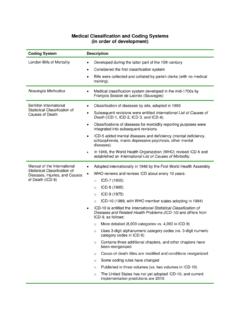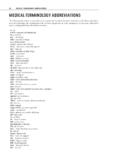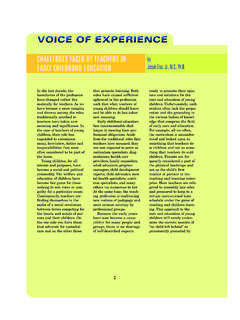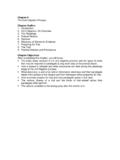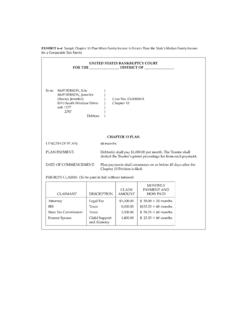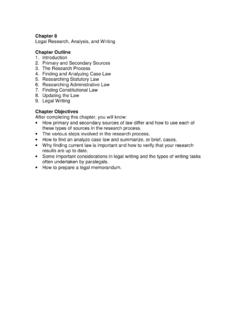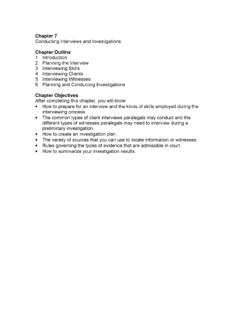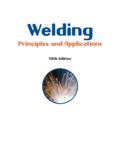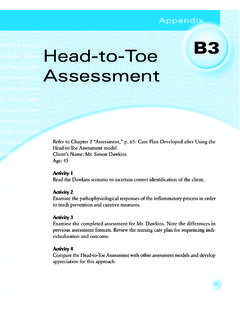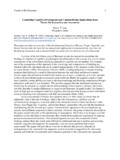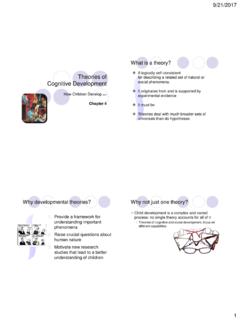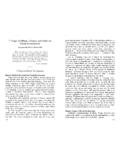Transcription of An Overview of Piaget’s Stages of Cognitive …
1 Copyright 2007 Thomson Delmar Learning. ALL RIGHTS month of life1 4 months4 8 months8 12 months12 18 monthsreflexive activityautomatic (unlearned) responsesto external stimulifive senses available for inputmotor activity centered on thebodysenses available to absorb inputcoordination of actionsestablishes simple habitsfocused on own needssimple anticipation of eventssome reflexes disappeardevelops schematic ideasdeliberate actions focus onrepeating interesting effectsdirect imitationfocused on selfsimple associationsincreased physical skillsenable infant to handle materialsmore effectivelybegins to organize schemesintentional behaviorgoal-directed activityobject-permanencephysical causality (beginning ofproblem solving)
2 Imitation with alterationsanticipates eventsmakes efforts to change eventsrecognizes that others exist but isfocused on selfdiscovers new means throughactive experimentationcombines and extends ideasbuilds schemes through morecomplex actionselaborates schemesbroader imitationstronger associations (linksbetween objects and ideas)sucks from the breastfeels the texture of her quilther random movements aresymmetricalbangs her hand against the side ofthe cribgazes at adultsrepetition of enjoyable actions sucks many objectsstares and touches something at thesame timecombines grasping and suckingsucks on own handscries when needs are not met but,initially, without deliberate attemptsto get attentionreaches for and grasps objectsmanipulates itemsrepeats interesting or surprisingactionscopies another baby banging with awooden spoonlinks objects by functionsits and passes toy from one hand tothe otherlooks for hidden objectsshakes rattle in different ways hides from Mom at bedtimecopies adult putting on a hat butmodifies what she has seenreaches for bib at feeding timemakes deliberate cries to getattentionplays peek-a-boo with older siblinguses new techniques to be successfulin putting shapes throughappropriate slotslooks in several places for a lost itemimitates parts of an adult rolediscovers the properties of Play-Dohaction occurs
3 Within a wider physicalspace, such as organizing self to playin sand at a distance from the adultAn Overview of piaget s Stages of Cognitive DevelopmentSTAGEAPPROXIMATE AGECHARACTERISTICSACTIVITY/PLAY EXAMPLESS ensorimotor stageSubstage 1 ReflexiveSensorimotor stageSubstage 2 Primary circularreactionsSensorimotor stageSubstage 3 Secondary circularreactionsSensorimotor stageSubstage 4 Coordination ofsecondary circularreactionsSensorimotor stageSubstage 5 Tertiary circularreactions(continues)Copyright 2007 Thomson Delmar Learning. ALL RIGHTS stageSubstage 5 Tertiary circularreactions (cont d)Sensorimotor stageSubstage 6 Internalization ofschemesPreoperational stage12 18 months (cont d)18 24 months2 3 years(continues through to 7 years)
4 Trial-and-error activityuses increased fine and grossmotor skills to reach goalsuses some basic symbolismuses simple languageextends play experiences to makethem more interestingrecognizes that others exist butremains focused on selfmental representation of realityinternalizes images of things andpast eventsbeginning of true thoughtdeferred imitationmake-believe activitycomplex schematic understandingacceptance of others but remainsfocused on selfearly categorizationinternalizes social behaviorssymbolic thoughtegocentric perspectiveinternalizes rolesprimitive reasoningdeceived by appearancescomplex deferred imitation andelaborationbuilds concepts associated withdirect experiencesmake-believerepresentation of ideasanimismputs objects together that belong,such as a number of toy carspoints to car and says car tries several ways of positioningpuzzle pieces to put puzzle togethercorrectlyvaries the way she performs actionsas she experiments with snowactivity with junk/found materials.
5 Where she combines materials andextends the enjoymentseeks adult help with play taskplays alone with a dollwatches older children playinguses a variety of strategies to solvethe problem of maneuvering a chairinto a small spacepretends to be mother or father inhouse playplay involves imaginary creaturesanticipates the ball emerging fromthe other end of a tubeuses words and simple language toconvey needs and ideasplays alongside others (but withoutinteraction)sorts a few items according to herown criteria , things that Ilike recognizes objects and people inpicturesattempts to soothe another childwhen she is hurt, in imitation ofadult response (not true empathy)plays alongside or with otherchildren, having learned the conceptof turn-takinghas difficulty in understandinganother child s perspective (why shewants the same toy)thinks that another child has more toeat because his portion is spread outover the plateinvolved in water play, discoversfloating and sinkingsociodramatic play sequencesinvolving other childrenAn Overview of piaget s Stages of Cognitive Development (continued)STAGEAPPROXIMATE AGECHARACTERISTICSACTIVITY/PLAY EXAMPLESC opyright 2007 Thomson Delmar Learning.
6 ALL RIGHTS strategies for problemsolvingtransductive reasoningmagical thinkingconstructs own realitycategorization using one attributewide range of conceptualizations:color, weight, size, things thatfloat/sink, what to wear, things toeat, imaginative thinkingindications of creativityremembers and follows aninstructionpaints in ways that express her ownideas and feelingsbelieves that her teddy can hear hertalking (animism)thinks that the puppet lady is comingtoday because it is raining (becausewhen she came last week it wasraining)responds positively to request to putitem into garbage binrefuses to go to bed without theritual sequence of story arrangement of toys on bed good-night kisssorts small toys according to color(but forgets the criterion after aperiod of time)
7 STAGEAPPROXIMATE AGECHARACTERISTICSACTIVITY/PLAY EXAMPLESP reoperational stage (cont d)2 3 years(continues through to 7 years)(cont d)
